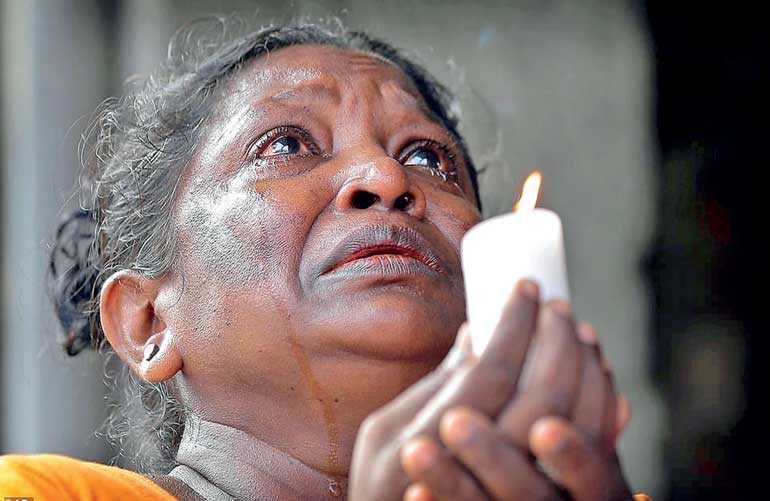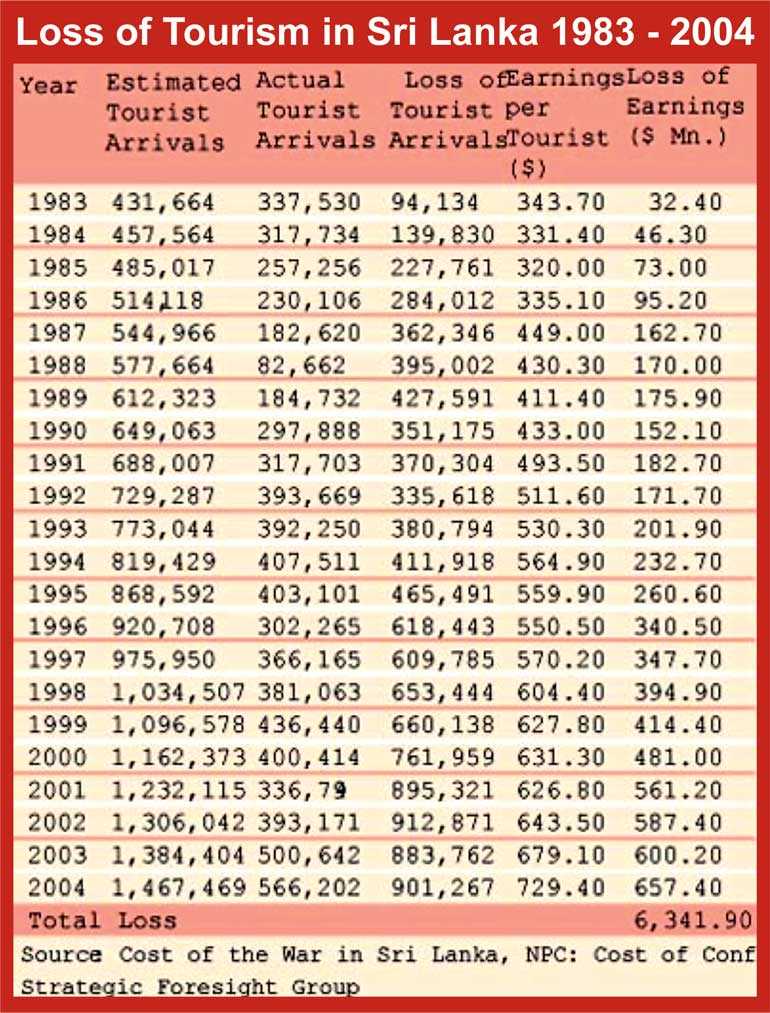Monday Apr 07, 2025
Monday Apr 07, 2025
Thursday, 9 May 2019 00:10 - - {{hitsCtrl.values.hits}}


The country is yet grappling to come to terms with the manmade disaster on 21 April. The attendance at schools is slowly recovering whilst the private sector is returning to normalcy.
The Army Commander’s announcement that Sri Lanka is safe and returning to ‘business as usual’ is very reassuring given that Sri Lanka has lost confidence on the political hierarchy. It is been widely reported in media that the key personalities in the Government were informed of the impending attacks that killed over 250 people many of whom where Catholic women and children in church.
Tourism – Eight months to recover
The tourism industry is challenged with balancing the political nuances and advisories. All key countries like the EU and US have issued ‘non-essential travel/to avoid’ whilst China has issued a ‘ban on travel to Sri Lanka’. For the first time India has issued an advisory which is strange but realistic, as the country advised the Sri Lankan Government almost two weeks before the attack and no action was taken.
 If we track the ISIS attacks globally, Egypt has had eight attacks where 320 people have been killed, France has had 12 attacks where 237 people have been killed with 847 people injured. We have seen similar attacks in Bali and the pickup is that it takes eight to 10 months to recover. Some industry experts put this number at one year.
If we track the ISIS attacks globally, Egypt has had eight attacks where 320 people have been killed, France has had 12 attacks where 237 people have been killed with 847 people injured. We have seen similar attacks in Bali and the pickup is that it takes eight to 10 months to recover. Some industry experts put this number at one year.
In my view, this is a good time for the industry to put the house in order. Appoint a PR agency, appoint a global advertising agency via the tender process, the hotels that need refurbishment can use this time to do it whilst we correct the issues related to tour guides and visiting key sites like Sigiriya and Yala in terms of carrying capacity per day. By the way, over-tourism is a theme that the World Tourism Organization is focusing on.
Policy makers – Away from reality
In my view the tourism industry must take leadership at this juncture as the political hierarchy is away from the reality.
Starting from the alerts that came on the impending attacks from the Indian authorities to how the subsequent interviews were faced by the President and Prime Minister clearly erodes the confidence level that the global community has in Sri Lanka. Even today as we speak, over 250 people have been buried with villages mourning for them, which includes the wealthiest person in Denmark, but no arrests or for that matter charges have been made by the Government of Sri Lanka. I feel the hierarchy must get the advice of the calibre of experts on terrorism like Prof. Rohan Gunaratne or for that matter the former Army Commander who have the experience of handling such ruthless organisations. I guess the declining ‘Business Confidence’ and ‘Consumer Confidence’ that have hit a low of 90 and 49 respectively as per the latest Nielsen index reflects the perception of the corporate sector in Q1, 2019 on the way the hierarchy has reacted to the situation. It will be interesting to see Q2 sentiments.
LTTE in 1983
Even though the country’s hierarchy is talking about the 137 odd cadres that the ISIS-liked entity has in Sri Lanka and how once they are destroyed this problem is over, that does not hold ground.
The LTTE was a smaller organisation way back in 1983. Prabhakaran apparently had only 12 cadres with just 20 shotguns in 1983, but by 2006 the LTTE had aircrafts, tanks, submarines, missiles and a brigade of more than 20,000 that is estimated to have wiped $ 200 billion off the Sri Lankan economy. Hence history tells us very clearly that we cannot take the surface pick up when terrorism strikes a country.
It needs a much more holistic view that was expressed by Professor Rohan Gunaratne who commented that unless the overall infrastructure and the fabrication is destroyed, that includes the funding sources linked to the political network, what Sri Lanka is up against is a worse situation than the LTTE.
Cost of the war – rebuilding
We cannot have a situation like what Sri Lanka was up against post the LTTE being eliminated in 2009. Apart from the five billion dollars that was spent to rebuild the Northern Province post the war, if we compute the taxes levied on the A9 Road by the LTTE when the private sector transported goods from the south to the north during the years the LTTE was in control of the Wanni, it is said to have cost the country almost another billion dollars.
Terrorism and quality of life
An important point to note is that in 2003/2004 the socio economic indicators reported that the access to pipe-borne water in the Northern Province was only 3.1% whilst in the east it registered 17.4%. The national average stood at a high 30.8%. The non-accessibility to toilets which is a stronger indicator of the quality of life registered in the north at 14.4% and the east, a staggering 29.2% whilst the national average stood at a respectable 5.6%, which again is a result of economic terrorism that has been at play for 27 years.
Terrorism impact – Tourism/FDIs
In 1983 Sri Lanka enjoyed 337,530 visitor arrivals whilst a country like Cambodia had around 200,000 tourists at that time. By 2009, Cambodia enjoyed over two million tourist arrivals whilst Sri Lanka was at low ebb of 0.5 million arrivals with a revenue of Rs. 43 billion.
If terrorism was not in existence Sri Lanka should have recorded around 1.8 million tourists at a very conservative estimate whilst earnings should have touched $ 2 billion. This on a GDP perspective would have been almost 8% to the country.
The Strategic Foresight Group which has researched this topic on the theme ‘Cost of the war in Sri Lanka’ has estimated through a simple extrapolation that the loss of revenue due to the curtailment of FDIs into the country is around Rs. 3,000 billion which is a clear indication of the challenges Sri Lanka will be up against unless groups likes Ava are curtailed early in the process.
Terrorism impact to R&D
Research reveals that around 400 billion was spent on the war in the period 2007-2009 and divert it to the investment that could have been made on Research and Development (R&D), the numbers will stack up to almost 7% of GDP. This would beat the 4% GDP spend that economic tigers like South Korea invested to build power brands like Samsung. This gives us an idea of the opportunity cost that economic terrorism has had in making Sri Lanka an innovation hub for South Asia.
Terrorism impact on exports
A point that can contribute to the concept of economic terrorism in the apparel sector is as follows. If we analyse the Revealed Comparative Advantage (RCA) score for Sri Lanka we see that Sri Lanka scores a high of 16.7 on being a supplier of clothes but scores a low 1.05 on being a textile supplier.
This can be attributed to the non-strategic direction in which this industry has been developed by the State in the 20 years of war due its focus on containing the LTTE. This also accounts for economic terrorism that existed in the face of Sri Lanka that diverted the overall strategic direction that Sri Lanka could have enjoyed if not for the war.
Conclusion
Hence we see the impact of terrorism in a country and in numbers the total can exceed 200 billion dollars. To give a better idea this value is almost three times Sri Lanka’s current GDP value. Sri Lanka cannot have another repeat of history.
[The writer is the President/CEO of a global AI company. He was the Head of Economic Affairs of the Government Peace Secretariat during 2007-2009 during the 4th Eelam war. Dr. Athukorala championed the construction of the Atchchuveli Industrial Zone when he worked for the United Nations (UNOPS).]

Discover Kapruka, the leading online shopping platform in Sri Lanka, where you can conveniently send Gifts and Flowers to your loved ones for any event including Valentine ’s Day. Explore a wide range of popular Shopping Categories on Kapruka, including Toys, Groceries, Electronics, Birthday Cakes, Fruits, Chocolates, Flower Bouquets, Clothing, Watches, Lingerie, Gift Sets and Jewellery. Also if you’re interested in selling with Kapruka, Partner Central by Kapruka is the best solution to start with. Moreover, through Kapruka Global Shop, you can also enjoy the convenience of purchasing products from renowned platforms like Amazon and eBay and have them delivered to Sri Lanka.
Discover Kapruka, the leading online shopping platform in Sri Lanka, where you can conveniently send Gifts and Flowers to your loved ones for any event including Valentine ’s Day. Explore a wide range of popular Shopping Categories on Kapruka, including Toys, Groceries, Electronics, Birthday Cakes, Fruits, Chocolates, Flower Bouquets, Clothing, Watches, Lingerie, Gift Sets and Jewellery. Also if you’re interested in selling with Kapruka, Partner Central by Kapruka is the best solution to start with. Moreover, through Kapruka Global Shop, you can also enjoy the convenience of purchasing products from renowned platforms like Amazon and eBay and have them delivered to Sri Lanka.